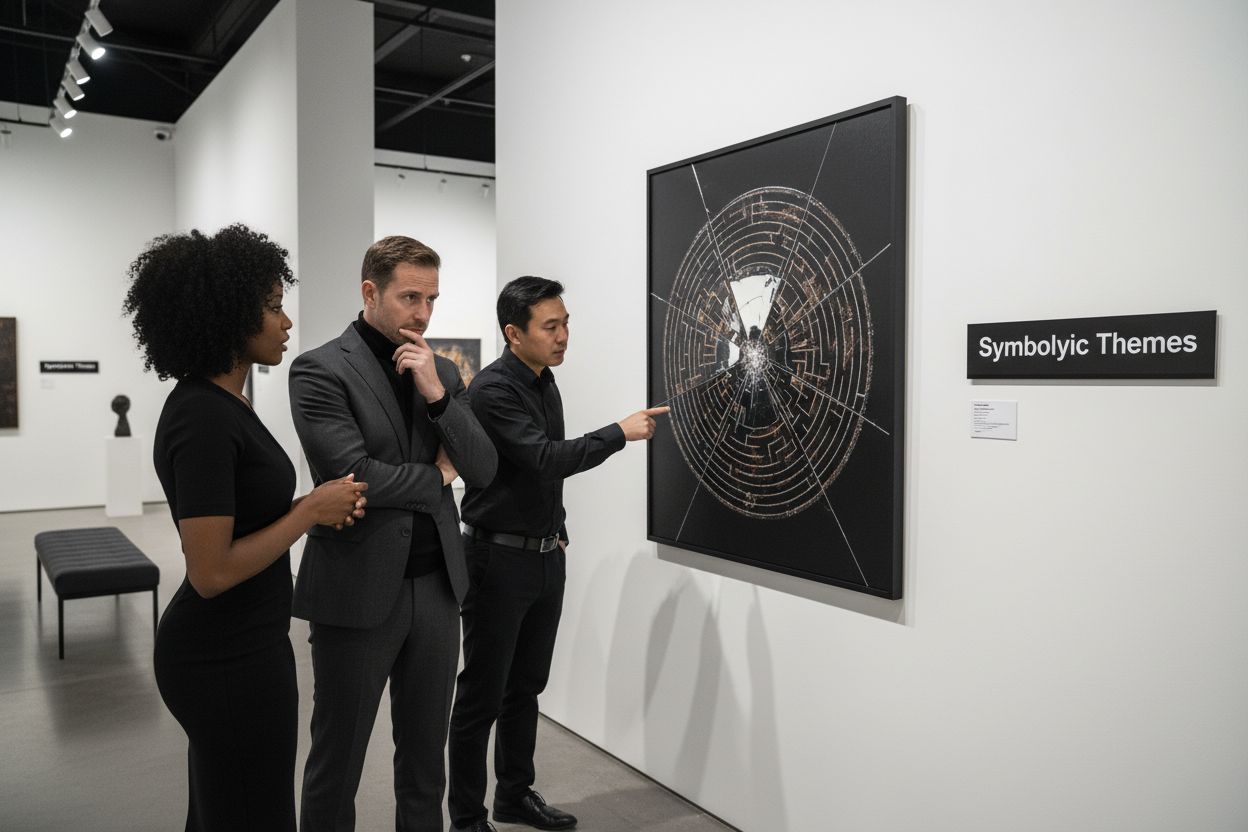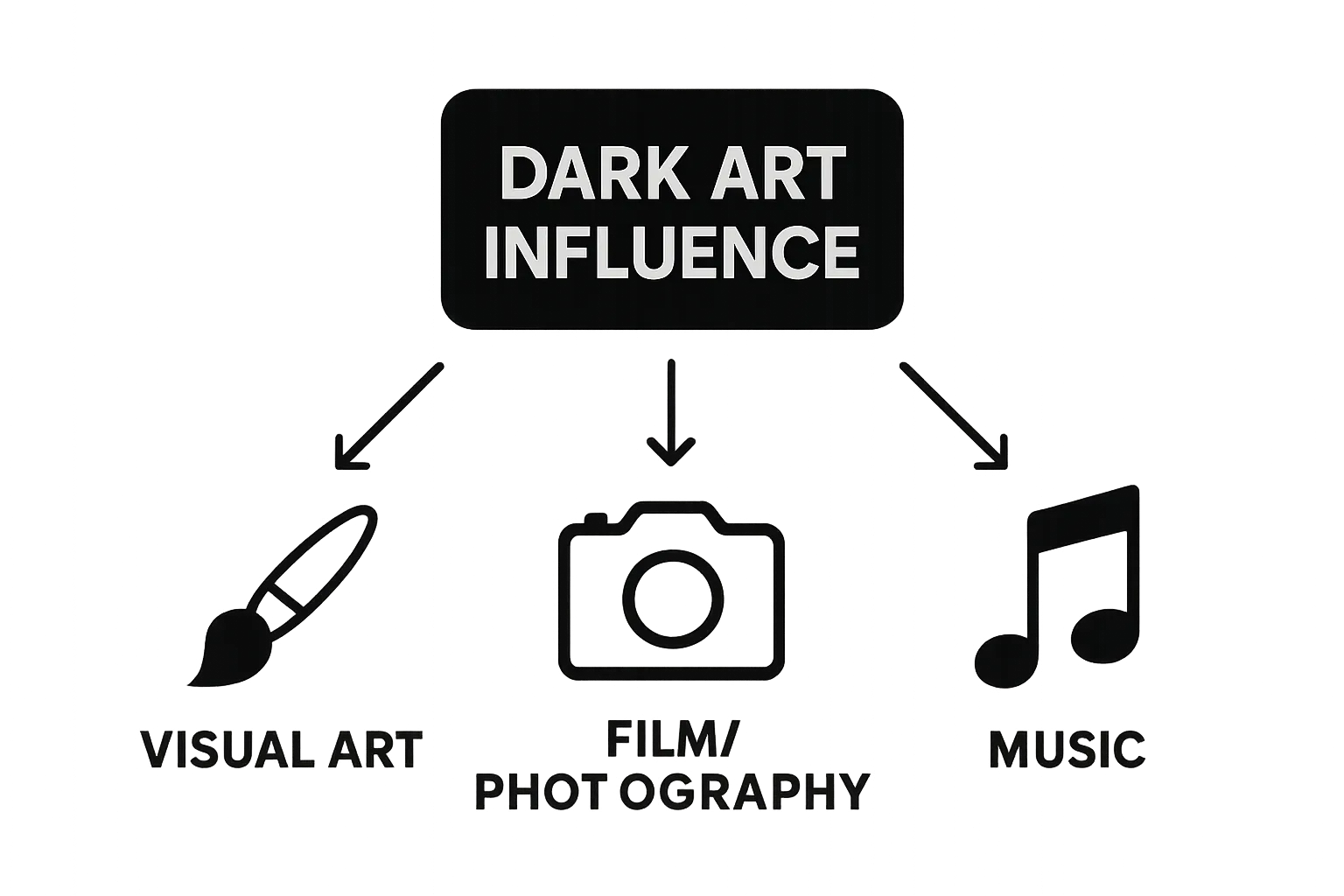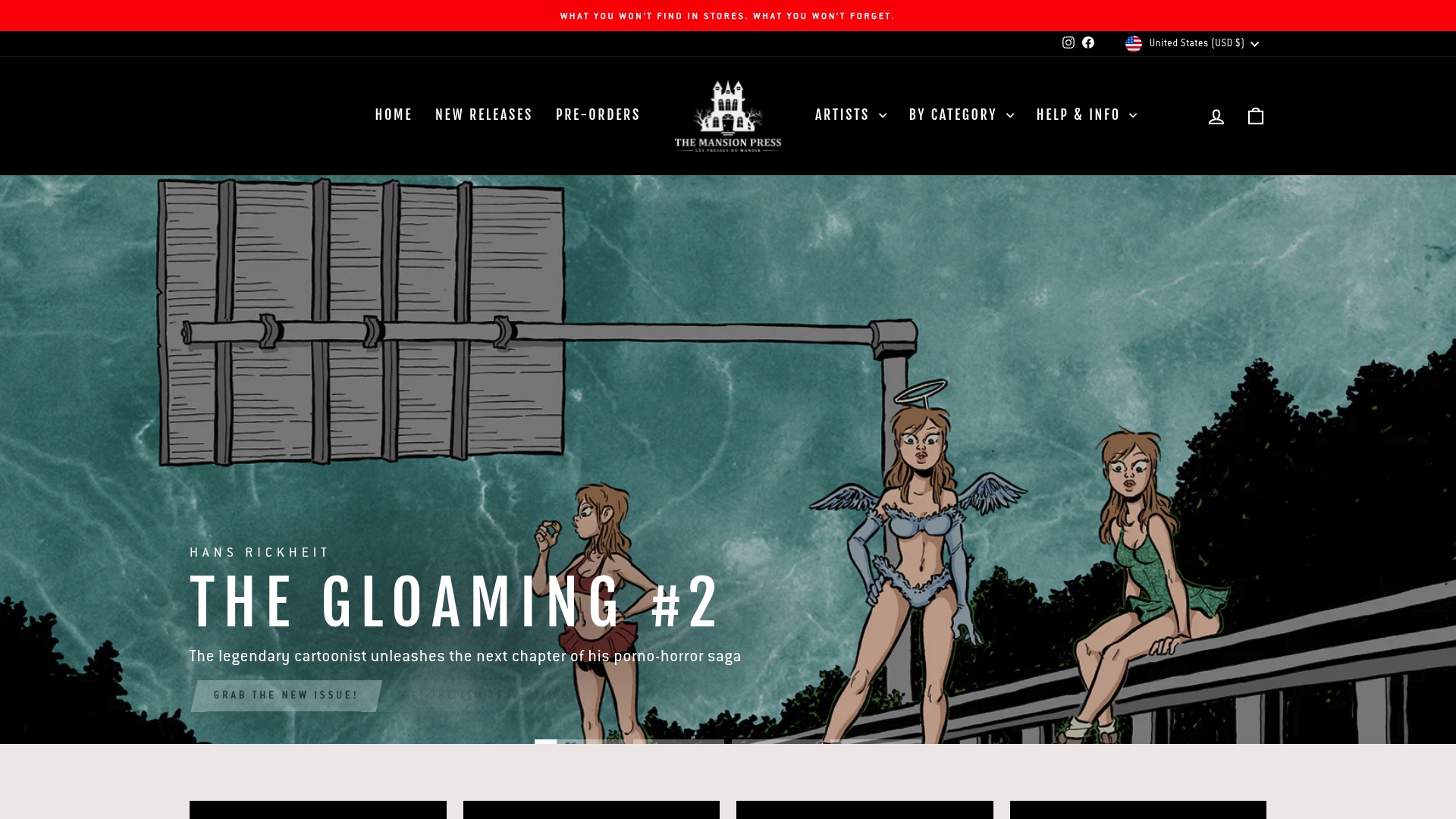Understanding Finding Inspiration in Dark Art
Dark art is making waves in the creative world, shaking up what people expect from painting and visual storytelling. Most visitors are surprised to learn that over 40 percent of contemporary artists are now experimenting with dark themes and psychological symbols, according to Art Basel’s latest report. Some think this kind of art is just shock value, but it turns out these pieces go much deeper, helping both artists and viewers process emotions that regular art often leaves untouched.
Table of Contents
- What Is Dark Art And Its Cultural Relevance?
- The Emotional And Psychological Dimensions Of Dark Art
- Key Themes And Symbols In Dark Art
- How Dark Art Influences Different Artistic Mediums
- Finding Personal Inspiration Through Dark Artistic Elements
Quick Summary
| Takeaway | Explanation |
|---|---|
| Dark art challenges traditional aesthetics. | It disrupts established norms, inviting viewers to confront uncomfortable themes. |
| Symbolism in dark art conveys complex emotions. | Artists use visual metaphors to represent inner turmoil and psychological states. |
| Dark art provides therapeutic benefits. | Engaging with this genre allows for emotional processing and personal healing. |
| Explore hidden psychological landscapes through dark art. | Individuals can gain self-awareness by confronting their emotional complexities. |
| Dark art influences multiple artistic mediums. | Its techniques inspire creators across various fields, shaping innovative expressions. |
What is Dark Art and Its Cultural Relevance?
Dark art represents a provocative artistic movement that explores themes of psychological depth, emotional complexity, and visual representations of human darkness. This artistic genre transcends traditional aesthetic boundaries by confronting viewers with raw, often unsettling imagery that challenges conventional artistic norms.
Defining Dark Art’s Conceptual Landscape
Understanding finding inspiration in dark art requires recognizing its profound psychological dimensions. Dark art emerges as a powerful medium for artists to express complex emotional states, inner turmoil, and societal critiques through visually striking and emotionally intense imagery. Unlike traditional art forms that seek beauty or harmony, dark art intentionally disrupts viewers’ comfort zones.
According to Art Basel’s Contemporary Art Report, dark art has gained significant traction among contemporary artists seeking to challenge aesthetic conventions and explore deeper psychological landscapes. These artists often utilize techniques that provoke visceral emotional responses, creating works that are simultaneously uncomfortable and compelling.
Cultural Significance and Psychological Expression
Dark art serves multiple critical functions within artistic and cultural contexts:
- Provides a therapeutic outlet for exploring complex human emotions
- Challenges societal norms and artistic expectations
- Creates visual narratives about psychological experiences
- Confronts viewers with uncomfortable yet essential human truths
The genre represents more than mere aesthetic rebellion. It functions as a nuanced form of cultural commentary, allowing artists to communicate profound psychological insights through visual metaphors and symbolic representations. By embracing uncomfortable themes, dark artists create immersive experiences that invite viewers to confront their own inner complexities.
Research from The International Art Psychology Association suggests that dark art plays a crucial role in social discourse, enabling artists to articulate experiences that traditional communication methods might suppress. Through intentionally provocative imagery, artists transform personal and collective traumas into powerful visual narratives that challenge viewers’ perceptual boundaries.
While often misunderstood as merely shocking or grotesque, dark art represents a sophisticated artistic approach that demands intellectual and emotional engagement from its audience.
The table below compares key characteristics of traditional art versus dark art to clarify how dark art both challenges and expands conventional artistic expectations.
| Feature | Traditional Art | Dark Art |
|---|---|---|
| Main Focus | Beauty, harmony, aesthetic balance | Psychological depth, emotional complexity, inner darkness |
| Emotional Impact | Comfort, pleasure, reassurance | Discomfort, introspection, confrontation with unsettling themes |
| Approach to Symbolism | Decorative, classical motifs | Metaphorical, archetypal, explores trauma and vulnerability |
| Artistic Purpose | Preserve conventions, represent ideals | Challenge norms, process difficult emotions, provoke intellectual engagement |
| Typical Techniques | Balanced color, realism, proportion | Distorted forms, intense imagery, symbolic language |
| Viewer Engagement | Passive appreciation | Active emotional and intellectual participation |
| Popular Themes | Nature, beauty, mythology, history | Identity, mortality, suffering, existentialism |
The Emotional and Psychological Dimensions of Dark Art
Dark art represents a profound psychological canvas where artists explore the intricate landscapes of human emotion, transforming internal struggles into visual narratives that challenge conventional emotional representations.
Psychological Catharsis Through Visual Expression
Artists engaging with dark art frequently utilize their creative process as a therapeutic mechanism for processing complex emotional experiences. By translating raw psychological states into visual metaphors, they create powerful representations that transcend traditional emotional communication channels.
According to Psychology Today’s Research on Art Therapy, creative expression through dark art can serve as a critical mechanism for emotional regulation and psychological healing. Artists transform internal turmoil into external representations, effectively externalizing deeply personal psychological landscapes.
Emotional Processing and Psychological Mechanisms
The psychological dimensions of dark art involve several critical emotional processing strategies:
- Confronting subconscious fears through symbolic representation
- Transforming traumatic experiences into narrative visual forms
- Creating distance from overwhelming emotional experiences
- Developing personal resilience through artistic expression
Research from The Journal of Creative Behavior suggests that dark art functions as a sophisticated psychological mechanism for emotional exploration. By engaging with uncomfortable visual representations, artists and viewers alike can navigate complex emotional territories that traditional verbal communication might struggle to articulate.
Psychological studies reveal that finding inspiration in dark art involves more than aesthetic appreciation. It represents a nuanced process of emotional engagement, where viewers are invited to confront their own psychological complexities through the artist’s visual narrative. Dark art becomes a mirror reflecting unspoken emotional experiences, challenging individuals to recognize and process their internal psychological landscapes.
Through intentional visual provocations, dark art creates a safe psychological space for exploring emotions that are frequently marginalized or suppressed in mainstream artistic representations. This artistic approach transforms emotional vulnerability into a powerful form of personal and collective expression.
Key Themes and Symbols in Dark Art
Dark art communicates profound narratives through carefully constructed symbolic language, utilizing visual metaphors that penetrate deep psychological territories and challenge viewers’ perceptual boundaries.
Symbolic Representations of Inner Darkness
Symbols in dark art function as complex visual languages, translating abstract emotional experiences into tangible representations. Artists strategically deploy these symbols to communicate nuanced psychological states that transcend traditional narrative methods. Dark art symbols often emerge from collective unconscious archetypes, drawing on profound psychological and cultural imagery.
According to Oxford Art Online, dark art incorporates intricate symbolic systems that represent existential struggles, internal conflicts, and psychological transformations.
Critical Symbolic Themes in Dark Art
The symbolic landscape of dark art encompasses several fundamental thematic elements:
- Representations of human vulnerability and psychological fragmentation
- Explorations of mortality, suffering, and existential complexity
- Visual metaphors for inner emotional turbulence
- Deconstruction of societal psychological constructs
Research from Contemporary Art Studies reveals that finding inspiration in dark art involves understanding these intricate symbolic networks. Artists deliberately construct visual environments that challenge viewers’ perceptual comfort zones, using symbols as profound communication tools.
Dark art symbols frequently include archetypal imagery like broken mirrors representing fractured identity, skeletal forms symbolizing mortality, and labyrinthine landscapes depicting psychological complexity. These visual metaphors invite viewers into immersive experiences that challenge conventional aesthetic and emotional boundaries.

By transforming abstract psychological experiences into visceral visual representations, dark art creates powerful narrative spaces where symbolism becomes a language of emotional exploration and profound psychological insight.
This table summarizes major symbolic themes and recurring symbols in dark art, providing a quick reference for how artists communicate complex psychological concepts visually.
| Symbolic Theme | Example Symbols | Psychological/Emotional Meaning |
|---|---|---|
| Human Vulnerability | Broken mirrors | Fractured identity, self-reflection |
| Mortality and Suffering | Skulls, skeletal forms | Awareness of mortality, existential struggle |
| Emotional Turbulence | Stormy skies, labyrinths | Internal chaos, feeling lost or overwhelmed |
| Psychological Fragmentation | Shattered glass, cracks | Dissociation, mental struggle, integration |
| Societal Deconstruction | Urban decay, masked faces | Alienation, critique of social norms |
| Transformation | Snakes, butterflies | Change, personal evolution through adversity |
| Darkness as Metaphor | Shadows, voids | Unconscious fears, the unknown or unseen |
How Dark Art Influences Different Artistic Mediums
Dark art transcends traditional boundaries, profoundly influencing diverse artistic disciplines through its unique visual language and psychological depth. This transformative artistic approach creates intricate connections between various creative expressions, challenging conventional aesthetic norms.
Cross-Disciplinary Artistic Transformation
The impact of dark art extends far beyond visual representation, fundamentally reshaping how artists across different mediums conceptualize emotional and psychological narratives. By introducing complex symbolic systems and provocative imagery, dark art provides creators with innovative tools for exploring human experience.
According to Tate Modern’s Research Publication, dark art has significantly influenced artistic expression by introducing techniques that challenge traditional aesthetic boundaries and invite deeper psychological exploration.
Interdisciplinary Artistic Manifestations
Finding inspiration in dark art generates profound creative intersections across multiple artistic domains:
- Graphic novels incorporating visceral psychological imagery
- Cinematic narratives exploring existential themes
- Photographic works challenging perceptual boundaries
- Musical compositions expressing complex emotional landscapes
The transformative power of dark art lies in its ability to communicate universal emotional experiences through provocative visual metaphors. By transcending traditional representational limitations, artists can explore complex psychological territories that conventional artistic methods might suppress.

Research from Contemporary Performance Studies demonstrates how dark art techniques enable creators to develop sophisticated narrative strategies that challenge audience expectations. These approaches allow artists to deconstruct traditional storytelling mechanisms and create immersive experiences that provoke intellectual and emotional engagement.
Ultimately, dark art functions as a dynamic creative language, enabling artists across disciplines to explore the intricate landscapes of human experience through powerful, unconventional visual and narrative strategies.
Finding Personal Inspiration Through Dark Artistic Elements
Personal inspiration through dark art emerges as a transformative journey of self-discovery, where individuals engage with artistic expressions that challenge conventional emotional landscapes and invite profound introspection.
Inner Landscape Exploration
Finding inspiration in dark art requires a willingness to confront personal psychological territories that often remain unexplored. Artists and viewers alike discover unique pathways for emotional expression by embracing artistic elements that illuminate complex inner experiences.
According to Art Psychology Research Institute, dark artistic elements provide powerful mechanisms for personal transformation, enabling individuals to translate abstract emotional experiences into tangible creative expressions.
Psychological Self-Discovery Strategies
Personal engagement with dark art involves several critical introspective approaches:
- Recognizing and acknowledging hidden emotional landscapes
- Transforming personal vulnerabilities into creative strength
- Developing emotional resilience through artistic interpretation
- Creating metaphorical representations of internal experiences
The psychological power of dark art lies in its ability to provide safe spaces for emotional exploration. By engaging with visual representations that challenge comfort zones, individuals can develop deeper understanding of their complex emotional experiences.
Research from Contemporary Creativity Studies demonstrates that dark artistic elements function as powerful tools for personal psychological mapping. These creative approaches enable individuals to externalize internal struggles, transforming potentially overwhelming emotional experiences into meaningful artistic narratives.
Ultimately, finding personal inspiration through dark art represents a profound journey of self-discovery. By embracing artistic elements that reveal uncomfortable yet essential emotional truths, creators and viewers can develop more nuanced, compassionate understanding of their inner psychological landscapes.
Find Your Next Source of Dark Art Inspiration at The Mansion Press
Struggling to find unique ways to channel your fascination with complex emotional themes and bold visual storytelling, just like the article described? Many art lovers and creators face the challenge of accessing truly original, limited-edition works that deeply explore psychological depth. The search for collector’s pieces or artbooks reflecting ideas like inner darkness, symbolism, or personal transformation often feels overwhelming. At The Mansion Press, you can discover captivating artbooks, comics, and original works from independent artists who embrace these very themes.

Experience firsthand what it means to own art that tells real psychological stories. Browse our curated selection at The Mansion Press, where every product listing is crafted for collectors and fans of unconventional art. Secure your next limited-edition piece or original artwork today. Supplies are limited and new releases frequently sell out. Bring a piece of authentic dark art into your collection now and deepen your connection to the emotional power of creative expression.
Frequently Asked Questions
What is dark art?
Dark art is an artistic movement that explores themes of psychological depth, emotional complexity, and human darkness through unsettling imagery that challenges conventional norms.
How does dark art relate to psychological expression?
Dark art serves as a powerful medium for artists to express complex emotions and societal critiques, enabling them to confront viewers with essential human truths and inner turmoil.
What are the key themes in dark art?
Key themes in dark art include representations of human vulnerability, explorations of mortality, visual metaphors for inner emotional turbulence, and the deconstruction of societal psychological constructs.
How can one find inspiration in dark art?
Finding inspiration in dark art requires engaging with its provocative imagery and themes, allowing individuals to confront their own psychological complexities and transform personal emotional experiences into creative expressions.

